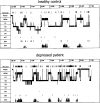Sleep Disturbances in Pediatric Depression
- PMID: 22287998
- PMCID: PMC3265574
- DOI: 10.1016/j.ajp.2011.09.001
Sleep Disturbances in Pediatric Depression
Abstract
Depressive illness beginning early in life can have serious developmental and functional consequences. Therefore, understanding its etiology and pathophysiology during this developmental stage is critical for developing effective prevention and intervention strategies. There is considerable evidence of sleep alterations in adult major depressive disorder. However, studies in children and adolescents have not found consistent changes in sleep architecture paralleling adult depression. This review article summarizes sleep polysomnography research in early-onset depression, highlighting the factors associated with variable findings across studies. In addition, potential avenues for future research will be suggested in order to develop more comprehensive theoretical models and interventions for pediatric depression.
Conflict of interest statement
The author has no conflicts of interest.
Figures

Similar articles
-
[Influence of depressive history on biological parameters in major depression].Encephale. 2002 Jan-Feb;28(1):51-8. Encephale. 2002. PMID: 11963343 French.
-
Sleep and depression in children and adolescents.Sleep Med Rev. 2005 Apr;9(2):115-29. doi: 10.1016/j.smrv.2004.09.006. Sleep Med Rev. 2005. PMID: 15737790 Review.
-
Sleep polysomnography as a predictor of recurrence in children and adolescents with major depressive disorder.Int J Neuropsychopharmacol. 2001 Jun;4(2):159-68. doi: 10.1017/S1461145701002383. Int J Neuropsychopharmacol. 2001. PMID: 11466166
-
Characteristics, correlates, and outcomes of childhood and adolescent depressive disorders.Dialogues Clin Neurosci. 2009;11(1):45-62. doi: 10.31887/DCNS.2009.11.1/urao. Dialogues Clin Neurosci. 2009. PMID: 19432387 Free PMC article. Review.
-
Peri-sleep-onset cortisol levels in children and adolescents with affective disorders.Biol Psychiatry. 2006 Jan 1;59(1):24-30. doi: 10.1016/j.biopsych.2005.06.002. Epub 2005 Aug 22. Biol Psychiatry. 2006. PMID: 16112658 Free PMC article.
Cited by
-
Association Between Major Depressive Disorder and Sleep Disturbances Through Inflammation in Adolescents.Front Psychiatry. 2020 Sep 15;11:559272. doi: 10.3389/fpsyt.2020.559272. eCollection 2020. Front Psychiatry. 2020. PMID: 33192676 Free PMC article.
-
Biomarkers in pediatric depression.Depress Anxiety. 2013 Sep;30(9):787-91. doi: 10.1002/da.22171. Epub 2013 Aug 22. Depress Anxiety. 2013. PMID: 24002798 Free PMC article. Review. No abstract available.
-
Association of Sleep Architecture and Physiology with Depressive Disorder and Antidepressants Treatment.Int J Mol Sci. 2021 Jan 29;22(3):1333. doi: 10.3390/ijms22031333. Int J Mol Sci. 2021. PMID: 33572767 Free PMC article. Review.
-
Rapid Eye Movement Sleep Abnormalities in Children with Pediatric Acute-Onset Neuropsychiatric Syndrome (PANS).J Clin Sleep Med. 2016 Jul 15;12(7):1027-32. doi: 10.5664/jcsm.5942. J Clin Sleep Med. 2016. PMID: 27166296 Free PMC article.
-
Continued Presence of Period Limb Movements During REM Sleep in Patients With Chronic Static Pediatric Acute-Onset Neuropsychiatric Syndrome (PANS).J Clin Sleep Med. 2018 Jul 15;14(7):1187-1192. doi: 10.5664/jcsm.7222. J Clin Sleep Med. 2018. PMID: 29991427 Free PMC article.
References
-
- Adrien J. Neurobiological bases for the relation between sleep and depression. Sleep Med Rev. 2002;6:341–351. - PubMed
-
- Agargun MY, Besiroglu L, Cilli AS, Gulec M, Aydin A, Inci R, Selvi Y. Nightmares, suicide attempts, and melancholic features in patients with unipolar major depression. Journal of Affective Disorders. 2007;98:267–270. - PubMed
-
- Akiskal HS, Lemmi H, Yerevanian B, King D, Belluomini J. The utility of the REM latency test in psychiatric diagnosis: a study of 81 depressed outpatients. Psychiatry Res. 1982;7:101–110. - PubMed
-
- Akiskal HS, Rosenthal TL, Haykal RF, Lemmi H, Rosenthal RH, Scott-Strauss A. Characterological depressions. Clinical and sleep EEG findings separating ‘subaffective dysthymias’ from ‘character spectrum disorders’. Arch Gen Psychiatry. 1980;37:777–783. - PubMed
-
- Alfaro-Rodriguez A, Labra-Ruiz N, Carrasco-Portugal M, Gonzalez-Maciel A, Perez-Guille B, Soriano-Rosales R, Villegas F, Gonzalez-Pina R, Espinoza-Villanueva G, Ayala-Guerrero F. Effect of carbamazepine on sleep patterns disturbed by epilepsy. Proc West Pharmacol Soc. 2002;45:62–64. - PubMed
Grants and funding
LinkOut - more resources
Full Text Sources

